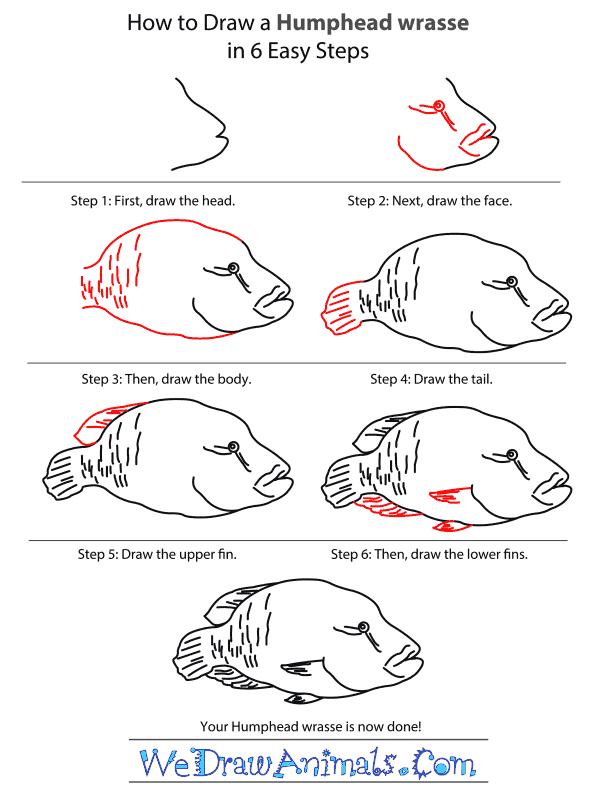In this quick tutorial you'll learn how to draw a Humphead Wrasse in 6 easy steps - great for kids and novice artists.
The images above represent how your finished drawing is going to look and the steps involved.
Below are the individual steps - you can click on each one for a High Resolution printable PDF version.
At the bottom you can read some interesting facts about the Humphead Wrasse.
Make sure you also check out any of the hundreds of drawing tutorials grouped by category.
How to Draw a Humphead Wrasse - Step-by-Step Tutorial
Step 1: Draw the outline of the head. Make sure to indent it slightly for the moth
Step 2: Add lines near the mouth for more detail. Add the eyes, along with lines for creases below and around the eye.
Step 3: Draw the body, leaving a space for the tail. Add small lines at the back of the wrasse
Step 4: Add the tail. Draw the outline, and then add longer lines horizontally across the tail
Step 5: Draw the upper fin by drawing a curved line from the back to the tail and then adding lines in the section created
Step 6: Draw the three lower fins. The largest one is similar to the upper fin. The other two are smaller and have fewer lines
Interesting Facts about the Humphead Wrasse
Found patchily throughout reefs in the Indo-Pacific region the HumpHead Wrasse is easily spotted by the large lump on its forehead and its thick lips. It’s one of the largest and most long lived coral reef fishes, living up to 30 years and growing to 6ft (2m) in length.
Did you know?
- Humphead Wrasse are one of the only predators of toxic animals like the crown-of-thorns starfish and are immune to their poisons.
- Humphead Wrasse can weigh up to 420lbs.
- They start out life as females but often transform into males but what causes the transition is unkown.
- Humphead Wrasse mature late in life making them vulnerable to over-exploitation.
- They are highly prized as a luxury food in some Asian countries.
Lesson plan note: Humphead Wrasse are easily exploited because their breeding sites are predictable making conservation difficult. Have students come up with their own ideas on how to overcome the problem of protecting the Humphead Wrasses breeding sites. Choose five to discuss in-depth as a class and ask if students think these methods could be used to help other endangered fish species similar to the Wrasse.







